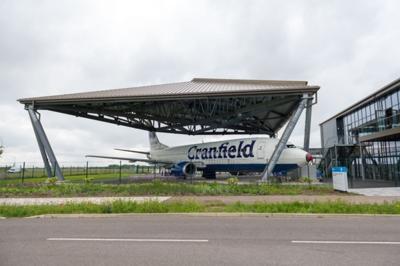My Hero, Zero …
Cranfield University—a British postgraduate-only public research university specializing in science, engineering, design, technology, and management—has joined the European Alliance for Zero-Emission Aviation, a voluntary initiative comprising public and private partners endeavoring to prepare the aerospace market for the emergence of zero-emission hydrogen-powered and electric aircraft.

Cranfield is the Alliance’s only U.K. university.
Cranfield was founded in 1946 as the College of Aeronautics (CoA). Throughout the 1950s and 1960s, the successes of the institution’s aeronautical research occasioned growth and diversification into disciplines the likes of manufacturing and management. In 1969, the College of Aeronautics was renamed the Cranfield Institute of Technology, incorporated by royal charter, became a university, and was granted authorization to award academic degrees. The moniker Cranfield University was adopted in 1993.
Cranfield University maintains two campuses: the primary campus is at Cranfield, Bedfordshire; and a secondary campus at the Defense Academy of the United Kingdom at Shrivenham, southwest Oxfordshire. The main campus is unique in the United Kingdom (and Europe) insofar as it operates its own airport, Cranfield Airport, and aircraft. The latter are plied to teaching and research.
The introduction of hydrogen and battery-electric propulsion to combat CO2 emissions—though specious in the extreme—requires major changes throughout the extant air transport system’s airport operations, air traffic management, and energy network sectors.
Launched in 2022 by the European Commission, the European Alliance for Zero-Emission Aviation seeks to bring together key aviation stakeholders, to include aircraft manufacturers, airlines, airports, energy companies, fuel providers, certification agencies, passenger groups and regulators. The Alliance aims to provide solutions to the challenges inherent bringing zero-emission aviation to commercial flight. Broadly, Alliance members work to address priority topics the likes of hydrogen supply, aviation regulation, and integration of electric and hydrogen aircraft into European networks.
Professor Dame Helen Atkinson DBE FREng, pro-vice-chancellor of the School of Aerospace, Transport and Manufacturing at Cranfield University stated: “Cranfield University is at the forefront of the UK’s efforts to decarbonize aviation. Joining the Alliance builds on our existing strong links into industry and will enable us collectively to really move forward the delivery of zero carbon emissions flight.”

Dr. Jon Huete, Principle Research Fellow in Cranfield University’s Low Emissions Technologies and Combustion Group, is the academic lead for the Alliance within the University.
Cranfield has been researching hydrogen power and propulsion for decades and maintains a Hydrogen Research Network spanning production, storage, operations and propulsion. The University has significant expertise and capabilities germane to surmounting the challenges of sustainable aviation, decarbonizing travel, the green airport, environmental technologies, and sustainable materials and manufacture.
Cranfield University was heavily involved in the Aerospace Technology Institute’s FlyZero program, which strived to realize zero-carbon-emission commercial aviation by 2030. The University spearheads the U.K. Aerospace Research Consortium’s hydrogen theme led by Prof. Bobby Sethi, who serves as the Head of the Low Emissions Technologies and Combustion group.
 Airborne 07.21.25: Nighthawk!, Hartzell Expands, Deltahawk 350HP!
Airborne 07.21.25: Nighthawk!, Hartzell Expands, Deltahawk 350HP! ANN's Daily Aero-Term (07.27.25): Estimated (EST)
ANN's Daily Aero-Term (07.27.25): Estimated (EST) ANN's Daily Aero-Linx (07.27.25)
ANN's Daily Aero-Linx (07.27.25) NTSB Final Report: Luce Buttercup
NTSB Final Report: Luce Buttercup Classic Aero-TV: 'That's All Brother'-Restoring a True Piece of Military History
Classic Aero-TV: 'That's All Brother'-Restoring a True Piece of Military History




